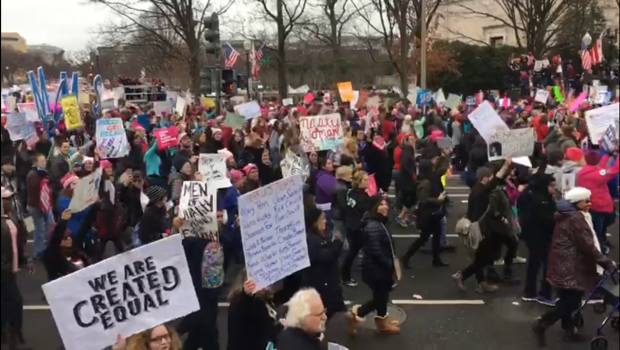Is the Women’s March the Beginning of the Resistance?
Patricia Gras
It’s been a month since I covered the Presidential inauguration parade and Women’s March 2017 for Literal Magazine and my show Passion Time. It was an unprecedented experience as a journalist and an American. During both events, the unexpected happened. President Trump was the first president outside of our political system, the oldest president ever elected and the first billionaire. The Women’s March not only happened in Washington but in 600 cities here and around the world. It drew around 3.4 million to 4.5 million people and protests took place on 7 continents. It has been described as the largest single-day peaceful demonstration ever in the United States by several news outlets. The march was mainly in opposition to social circumstances leading to presidency of Donald Trump: His sexual misconduct, the many sexual allegations against him, the serious threat his administration poses to women’s health and productive rights, and to remind President Trump that “women’s rights are human rights.”
The organizers described it as the “protection of our rights, our safety, our health and our families, recognizing that our vibrant and diverse communities are the strength of the country.” They also aimed to bring together people of all backgrounds to “affirm our shared humanity and pronounce our bold message of resistance and self-determination.”
One grandmother in Hawaii unknowingly started the march. Theresa Shook wrote a Facebook post expressing her displeasure with President Trump’s election. She then suggested a call to action to 40 of her friends: a march in Washington, DC. This was then posted on the Pantsuit Nation Facebook Group, which has nearly 4 million followers. In one day 10,000 people signed up. Eventually, thousands signed up and over half a million showed up in Washington.
I began my interviews on my way to the march. In the subways, we were packed like sardines. My first interview was with a Brooklyn artist standing next to me who had painted a poster of Trump and a cat that read “We grab back.”
As I walked through the crowds I was surprised at the number of men who were present, the creativity of the signs, and the thousands of pink pussycat hats.
Organizers wanted to reclaim the derogatory term “pussy” based on President Trump’s remarks that women would let him grab them by the pussy, so they wore the hats as a reminder his statement was not forgotten and had become a symbol of resistance.
If you were to describe what all these different groups standing for women’s rights, environmental rights, human rights, immigrant rights, minority rights etc. had in common was their disdain for President Trump’s misogynistic and reprehensible statements and potential policies.
Here are some of the most interesting signs I read: “Fight like a girl,” “I stand against hate,” “It’s not a Business, it’s a planet,” “Make America smart again,” “Our voices have value,” “We will not be silenced,” “Feminist is not a bad word,” “The very concept of objective truth is fading out of the world. –George Orwell,” “We can’t believe we still have to protest this shit,” “There is no planet B,” “Women’s Rights are Human Rights,” “Build Bridges, not Walls,” “All Lives matter!” “Stop Being Mean,” “Nasty and Proud,” “Hear us Roar,” and “Bitches get shit done.”
A month later, the question many Americans have asked remains: What now? Will this march create a movement, or was it just a one-time event? If the Tea Party could reject President Obama’s agenda organizing locally and convincing their members of congress against a popular president, can these protesters do the same against President Trump?
Marches are no substitute for ongoing political activism. Getting media attention and raising awareness are not enough. If the women and men who protested go back home, create a movement to seize political control of their city, state, and nation in the coming mid-term elections, then a change may come.
So far, here are some of the activities scheduled to take place. This spring will witness 5 more marches. On April 15th, a Tax March, which will request once again that President Trump release his taxes. On April 22nd, there will be a march for Science. On April 29th, a People’s Climate march is planned. On May 6th, an Immigrants’ march and on June 11th, a national Pride march.
There is also a boycott campaign called Grab Your Wallet or #grabyourwallet, which lists all the businesses that conduct business with President Trump or his family. The most well-known example is Nordstrom, which recently stopped carrying Ivanka Trump’s line of clothing and shoes.
As President Trump began releasing his many executive orders, millions continued to protest in the streets and airports, called their representatives or senators in opposition, and huddled to figure out how to resist more effectively.
Political satire shows are getting attention like never before. Saturday Night Live and many other comedy shows are seeing their ratings skyrocket when they lampoon the president and his staff.
But despite a constitutional crisis created by one executive order, the new concept of “alternative facts,” an unprecedented choice (Steve Bannon) to participate in the National Security Council, embarrassing phone calls with the Australian prime minister and President of Mexico and the many Twitter rants that make headline news, the resistance movement has had no impact on the majority of Republicans who still favor President Trump’s current policies and actions. They have the power, and the Democrats can’t stop them. The only branch of government that can hold the president accountable is the judicial branch and what is known as the fourth branch of government: the mainstream media he hates so much.
Much has been written about why the Democrats lost. They lost the middle class. They became entitled and they ceased to focus on what everyday Americans cared about but most importantly, the party became complacent, lazy, and apathetic.
American voter turnout is quite low. The US is rated 31 out of 35 countries in voter turnout. Only almost 60 percent of voters cast their ballots in this presidential election. Mid-term elections fare much worse, with around 37 percent of eligible voters participating. Many American voters simply have a very hard time voting because they can’t take a day off or they face obstacles such as convenience, income level and laws enacted by states that get in the way of voting. Many others just don’t care.
Like the Tea Party, what could change the political landscape are the results of the congressional and senate elections in 2018. If the so-called Resistance Movement’s loud voice becomes a vote, then maybe the march I covered served a purpose.
*Cover image & video by Patricia Gras
 Patricia Gras is a seven-time Emmy Award-winning journalist. She is the founder and producer of the online series Passion Time.
Patricia Gras is a seven-time Emmy Award-winning journalist. She is the founder and producer of the online series Passion Time.
©Literal Magazine
Posted: February 20, 2017 at 10:41 pm











Fantastic article and video. Thank you for sharing. I was there and am proud to attest to every word of it. We need to continue to #RESIST and fight for causes, human rights… even if they don’t represent us, necessarily. We are all in this together. Thank you, again, for documenting this monumental cry for our rights! We stand strong and together!